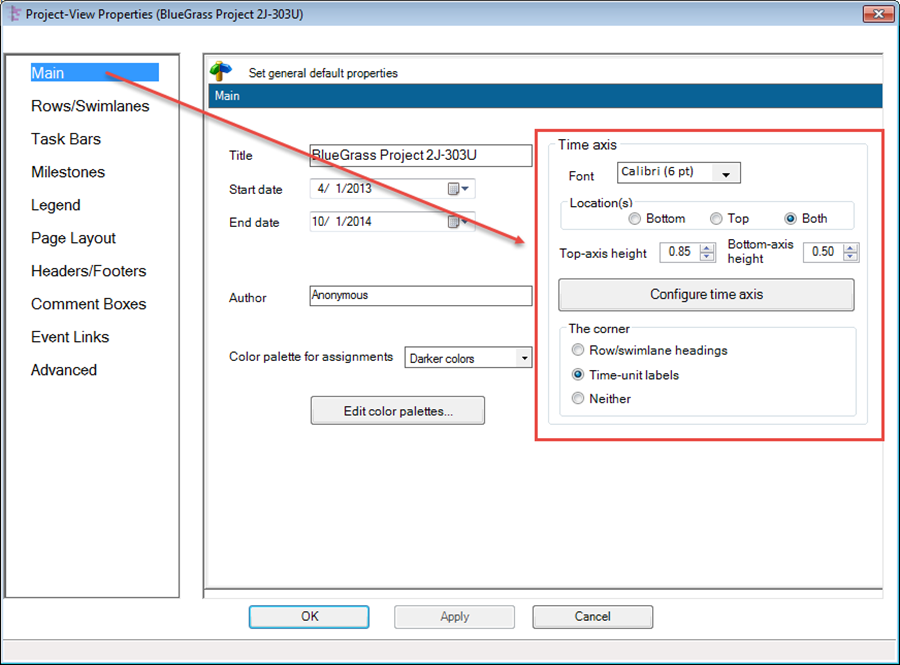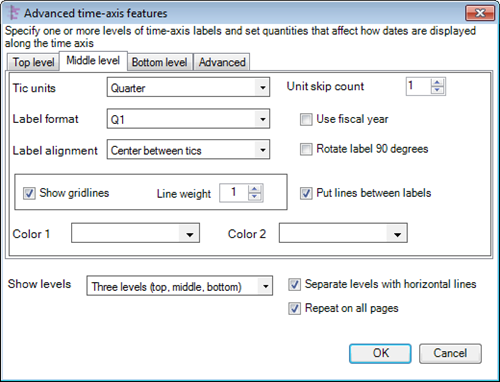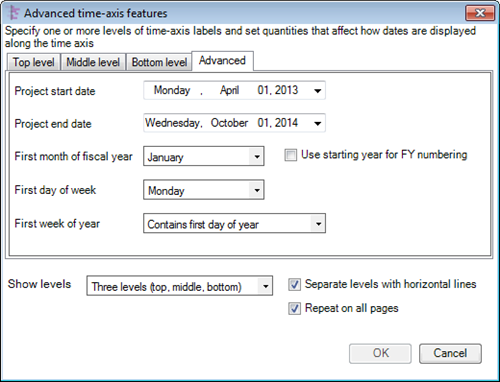Showing Different Units of Time
About Different Time Units
OnePager lets you specify up to three levels of time axis annotation as shown below:

Main Tab Time Axis Controls
1) To control time axis annotation beyond the simple one-level case, go to Project-View Properties (PVP) form and the Main tab shown below.
2) Then, go to the Time axis section in the upper right.
3) You can also right click anywhere on the time axis to see the controls as follows:

- a) Font Provides access to the standard Font properties form where the font style, font size, font text color, and the controls for Bold, Italic, and Underline can be set or changed.
- b) Location: Lets you to select the position of the time axis which may be set at the bottom, top or at both locations in the project view.
- c) Top Axis Height Lets you change the height of the time axis configuration at the top of the project viewview. The set increments are in user units which are either in inches or centimeters depending on the Windows culture settings.
- d) Bottom Axis Height Lets you change the height of the time axis configuration at the bottom of the project view. The set increments are in user units which are either in inches or centimeters depending on the Windows culture settings.
Configure Time Axis Button
4) Provides access to the Advanced time-axis features form shown below with its four tabs:

5) At the bottom of each Advanced time-axis features tab shown above and below, use Show levels dropdown to choose whether you want one, two, or three levels of time axis annotation to be displayed.
6) Use the Separate levels with horizontal lines to put a separation line between levels on the time axis. The middle level is the only level displayed if you choose to have just one level. For each time axis level, you can specify the following information:
- i) Tic units: The time unit between each tic mark (tic units). Examples are Year, Quarter, Month, and Week.
- ii) Unit skip count: How many time units to skip between labels (normally 1).
- iii) Label format: How the date information is displayed (label format). These label formats are very similar to those used in Microsoft Project. Examples are “Feb”, “F”, “February”, and “Feb ‘08”.
- iv) Use fiscal year: Whether or not to use fiscal year. There is a separate sub-group below dealing with the specification of fiscal year.
- v) Label assignment: How the labels are aligned. The most common choice is to center the labels between tic marks, as is shown above.
- vi) Rotate label 90 degrees: When checked, rotates the label to a vertical position.
- vii) Show gridlines: When checked, allows you to draw a long vertical gridline from top to bottom of screen for each tic unit.
- viii) Line weight: Specifying how thick you want to make gridlines.
- ix) Put lines between labels: When checked, this control allows you to separate each time unit by a vertical line, as is shown above.
2) At the bottom of the form are additional choices that apply to all levels.
- a) Separate levels with horizontal lines: If the “Separate levels with horizontal lines” check box is checked, this causes OnePager to draw horizontal lines that separate the levels, as shown in the example at the start of this sub-section. The horizontal lines are thin so as not to overpower the gridlines in the project view.
- b) Repeat on all pages: When checked, causes OnePager to place the time axis on ALL pages in a multi-page output.
The “Advanced” tab form below lets you control more properties of time axis labeling:

- a) Project start and end dates: These two windows are used as reference dates for computing the number of weeks (or months) from the beginning or end of the project.
- b) First month of fiscal year: Specifies the month in which the fiscal year begins.
- c) Use starting year for FY numbering: This check box tells OnePager whether the fiscal year is called by the name of the calendar year in which it starts. Normally this is unchecked, so that the fiscal year is called by the name of the calendar year in which it ends. For more information on how OnePager represents detailed aspects of the fiscal year on the time axis, see the next subsection.
- d) First day of week: Use this window control to designate when each week starts, when the time unit is “weeks”.
- e) First week of the year: Use this window control to tell OnePager if the first week of the year “Contains first day of the year” or if the first week of the year “Is the first full week of the year” where you have designated previously the “First day of the week” as described above.
The “Corner” group shown in the “Main” tab of the “Project-View Properties” is described in detail in a sub-group above.
(22.1)